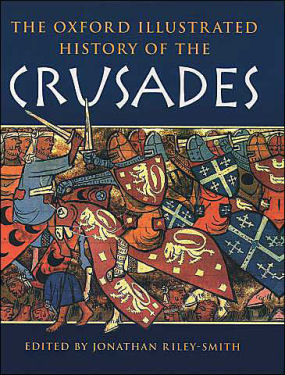
|
Posted January 13, 2006
Book: The Oxford Illustrated History of the Crusades Edited by Jonathan Riley-Smith Oxford University Press, New York, 1995, pp. 436 An Excerpt from the Jacket:
The volume includes detailed reference material: maps, chronology, a guide to further reading, and a full index. It will be welcomed by anyone interested in the ideals and history of the Crusades. An Excerpt from the Book: The Idea of Jihad Although initial Muslim responses to the coming of the crusades were inevitably confused and often couched in inappropriately archaic forms, some Muslim leaders swiftly came to grips with the full significance of the Christian invasion and set about trying to organize a counter-crusade. ‘Ali ibn Tahir al-Sulami (1039-1106) was a Sunni Muslim religious scholar attached to the great mosque of Damascus. His Kitab al-jihad (1105) was the first treatise on the Holy War to be produced after the arrival of the Franks in the Near East. Unlike some of his contemporaries, al-Sulami did not confuse the crusaders with Byzantines. Rather, he regarded the expedition of the Franks as part of a Christian ‘jihad’ from the West, which had the aim of helping native Christians as well as conquering Jerusalem. He presented the triumph of the crusaders in Syria as a symptom of the moral and political decay of Islam and of the enfeebled state of the caliphate, but he also offered his readers the certainty of future victory, since the Prophet Muhammad had predicted that the Muslims would lose Jerusalem for a while, but then they would not only retake it, but they would go on to conquer Constantinople. Al-Sulami was also aware of conflicts between Christianity and Islam which were going on in Spain, Sicily, and North Africa. His readiness to see the crusade within the broader context of a struggle between the two religions, extending all the way across the Mediterranean, was later to be closely echoed in a chronicle written by the thirteenth-century Mosuli historian Ibn al-Athir. . . . Although al-Sulami’s was the first jihad treatise to be written in response to the crusade, it was not the first book to be written on the subject. The ultimate authority for jihad is to be found in the Qur’an itself. “Prescribed for you is fighting, though it be hateful to you. (Qur’an II, 216)” “Fight those who believe not in God and the Last Day and do not forbid that God and His Messenger have forbidden – such men as practice not the religion of truth, being of those who have been given the Book -- until they pay tribute out of hand and have been humbled..” “And fight the unbelievers totally even as they fight you totally; and know that God is with the godfearing.” Jihad, which is commonly translated as ‘holy war’, literally means ‘striving’: that is striving to advance Islam. Table of Contents: 1. The crusading movement and historians 2. Origins 3. The Crusading Movement, 1096-1274 4. The state of mind of crusaders to the East, 1095-1300 5. Songs 6. The Latin East 1098-1291 7. Art in the Latin East 1098-1291 8. Architecture in the Latin East 9. The military orders 10. Islam and the Crusades 11. The crusading movement 12. The Latin East 13. The military orders 14. Images of the Crusades in the nineteenth and twentieth centuries 15. Revival and survival |
|
